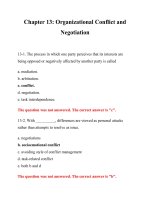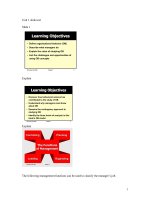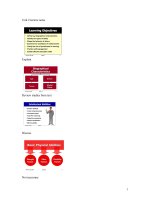Organizational behavior: Lecture 13 - Dr. Mukhtar Ahmed
Bạn đang xem bản rút gọn của tài liệu. Xem và tải ngay bản đầy đủ của tài liệu tại đây (649.38 KB, 55 trang )
Organizational
Behavior
(MGT-502)
Lecture-13
Summary
of
Lecture-12
Perception
Factors Influencing
Perception
• The Perceiver
• The Target
• The Situation
Attribution
The Process through which
individuals attempt to
determine the causes of others
behavior
Fundamental Attribution Error
The tendency to attribute others’
actions to internal causes (e.g their
traits) while largely ignoring external
factors that also may have influenced
their behavior.
Impression Management
Self-presentation
Is the process by which people attempt
to manage or control the perceptions
other form of them.
Perception &
Decision Making
Rational Decision-Making
Model
A decision-making model
that describes how
individuals should behave
in order to maximize
some outcomes.
Alternatives to
Rational Decision- Making
• Bounded Rationality
• Intuitive Decision-making
• Decision-Making by Objection
• The Garbage Can Model
A Model of Bounded Rationality
Ascertain
the Need
for a Decision
Select
Criteria
Identify a
Limited Set
of Alternatives
Compare
Alternatives
Against Criteria
Simplify
the Problem
Expand
Search for
Alternatives
Select the
First “Good
Enough” Choice
A “Satisficing”
No
Alternative
Exists
Yes
Intuitive Decision Making
High uncertainty levels
Little precedent
Hard to predictable variables
Limited facts
Unclear sense of direction
Analytical data is of little use
Several plausible alternatives
Time constraints
Tolerance for Ambiguity
Decision-Style Model
High
Analytical
Conceptual
Directive
Behavioral
Low
Rational
Intuitive
Way of Thinking
Criteria of Decision
Effectiveness
•
•
•
•
Quality
Timeliness
Acceptance
Ethical Appropriateness
Types of Managerial Decisions
• Programmed vs. Nonprogrammed
• Strategic vs. Operational
• Top-Down vs. Worker-Empowered
Methods of Improving Decision
Making in Organizations
• Human-based Methods
• Computer-based Methods
• Brainstorming
• Nominal Group Technique
• Delphi Method
Today’s Topics
Motivation
A state of mind, desire,
energy or interest that
translates into action.
• Motivation
–The inner drive that directs a
person’s behavior toward
goals.
Defining Motivation
The processes that account for an
individual’s intensity, direction and
persistence of effort toward attaining a
goal.
Key Elements
1. Intensity: how hard a person tries
2. Direction: toward beneficial goal
3. Persistence: how long a person tries
• Intensity is concerned with how hard a
person tries. This is the element most of us
focus on when we talk about motivation.
• Direction is the orientation that benefits the
organization.
• Persistence is a measure of how long a
person can maintain his/her effort. Motivated
individuals stay with a task long enough to
achieve their goal.
Why Do We Care?
Ability
PERFORMANCE
Motivation
Opportunity
Performance =
f (Ability, Motivation, Opportunity)
The Motivation
Process
Need
More money for
unexpected medical expenses
Goal-directed behavior
Ask for a raise
Work harder to gain a promotion
Look for a higher-paying job
Steal
Need Satisfaction
More money
Core Phases of
the Motivational
Process









